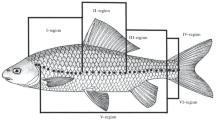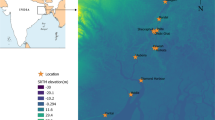Abstract
The marine catfish Genidens barbus is an anadromous species from South America. The aim of the present study was to evaluate the use of lapillus otolith microchemistry (Sr:Ca; Ba:Ca and Mg:Ca ratios) as an indicator of changes in habitat use and identify the potential breeding areas and fish stocks of G. barbus populations from the Plata Basin (Paraná River Delta and De la Plata River estuary-Argentina) and Lagoa dos Patos coastal lagoon (southern Brazil). Sr:Ca, Ba:Ca and Mg:Ca ratios were measured in the core area (inner 4 rings) and external area (outer 3–4 rings) of the otoliths by ICP-OES. The Sr:Ca ratio tended to be higher in the otolith external area than in the core area, while the Ba:Ca ratio followed the opposite pattern. This suggests the displacement of fish toward higher salinity areas. The Sr:Ca, Ba:Ca, Mg:Ca ratios in the core and external areas of the otoliths from the Plata Basin differed significantly from those of the otoliths from Lagoa dos Patos. This may indicate the occurrence of two different breeding sites and at least two fish stocks in the study region.



Similar content being viewed by others
References
Albuquerque CQ, Miekeley N, Muelbert JH, Walther BD, Jaureguizar AJ (2012) Estuarine dependency in a marine fish evaluated with otolith chemistry. Mar boil 159(10):2229–2239
Arslan Z, Secor DH (2008) High resolution micromill sampling for analysis of fish otoliths by ICP-MS: effects of sampling and specimen preparation on trace element fingerprints. Mar Environ Res 66(3):364–371
Avigliano E, Riaños Martinez C, Volpedo AV (2014) Combined use of otolith microchemistry and morphometry as indicators of the habitat of the silverside (Odontesthes bonariensis) in a freshwater-estuarine environment. Fish Res 149:55–60
Avigliano E, Volpedo AV (2013) Use of otolith strontium:calcium ratio as indicator of seasonal displacements of the silverside (Odontesthes bonariensis) in a freshwater-marine environment. Mar Freshw Res 64(8):746–751
Backhaus K, Erichson B, Plinke W, Weiber R (2006) Multivariate analysemethoden. Eine anwendungsorientierte Einführung, Springer, Berlin
Baigún CRM, Colautti D, López HL, Van Damme PA, Reis RE (2012) Application of extinction risk and conservation criteria for assessing fish species in the lower La Plata River basin, South America. Aquat Conserv Mar Freshw Ecosyst 22(2):181–197
Burke N, Brophy D, King P (2008) Otolith shape analysis: its application for discriminating between stocks of Irish Sea and Celtic Sea herring (Clupea harengus) in the Irish Sea. ICES J Mar Sci 65:1670–1675
Burns MD, Garcia AM, Vieira JP, Bemvenuti MA, Marques DM, Condini DM (2006) Evidence of habitat fragmentation affecting fish movement between the Patos and Mirim coastal lagoons in southern Brazil. Neotrop Ichthyol 4(1):69–72
Campana SE, Chouinard GA, Hanson JM, Frechet A, Brattey J (2000) Otolith elemental fingerprints as biological tracers of fish stocks. Fish Res 46(1):343–357
Campana SE, Thorrold SR, Jones CM et al (1997) Comparison of accuracy, precision and sensitivity in elemental assays of fish otoliths using the electron microprobe, PIXE and laser ablation ICPMS. Can J Fish Aquat Sci 54:2068–2079
Cury P (1994) Obstinate nature: an ecology of individuals. Thoughts on reproductive behavior and biodiversity. Fish Aquat Sci 51(7):1664–1673
DINARA (2013) Dirección Nacional de Recursos Acuáticos, Uruguay. http://www.dinara.gub.uy/web_dinara/. Accessed 20 Dec 2013
EPA (1994) Methods for the determination of metals in environmental samples, supplement 1, Ohio
Ferguson GF, Warda TM, Bronwyn M, Gillanders M (2011) Otolith shape and elemental composition: complementary tools for stock discrimination of mulloway (Argyrosomus japonicus) in southern Australia. Fish Res 110:75–83
Gaetani GA, Cohen AL (2006) Element partitioning during precipitation of aragonite from seawater: a framework for understanding paleoproxies. Geochim Cosmochim Acta 70:4617–4634
Galley E, Wright P, Gibb F (2006) Combined methods of otolith shape analysis improve identification of spawning areas of Atlantic cod. ICES J Mar Sci 63:1710–1717
Guerrero RA, Acha EM, Lasta CA (1997) Physical oceanography of the Río de la Plata Estuary, Argentina. Cont Shelf Res 17(7):727–742
Guerrero RA, Piola AR, Molinari G, Osiroff AP (2010) Climatología de temperatura y salinidad en el Río de la Plata y su Frente Marítimo, Argentina-Uruguay. 1° edn. Mar del Plata, Argentina
IBAMA (1999) Desembarque de pescados no Rio Grande do Sul. Annual Report, Centro de Pesquisa do Rio Grande, RS, Brasil
Jørgensen B, Rajeswaran J (2005) A Generalization of Hotelling’s T 2. Commun Stat Theor 34(11):2179–2195
Kerr LA, Campana SE (2013) Chemical Composition of Fish Hard Parts as a Natural Marker of Fish Stocks. In: Cadrin SX, Kerr LA, Mariani S (Eds.). Stock identification methods: applications in fishery science. Academic Press. pp 205–234
Kraus RT, Secor ER (2004) Incorporation of strontium into otoliths of an estuarine fish. J Exp Mar Biol Ecol 302:85–106
Longmore C, Fogarty K, Neat F, Brophy D, Trueman C, Milton A, Mariani S (2010) A comparison of otolith microchemistry and otolith shape analysis for the study of spatial variation in a deep-sea teleost, Coryphaenoides rupestris. Environ Biol Fishes 89(3–4):591–605
López HL, Miquelarena AM, Gómez JP (2005) Biodiversidad y Distribución de la Ictiofauna Mesopotámica. Miscelánea 14:311–354
López RB, Bellisio NB (1965) Contribución al conocimiento del Tachysurus barbus (Lacepede), bagre del mar argentino (Pisces. Ariidae). In: Anais do Segundo Congreso Latino-Americano de Zoología, São Paulo, Brasil, pp 145–153
Mai AC, Condini MV, Albuquerque CQ, Loebmann D, Saint’Pierre TD, Miekeley N, Vieira JP (2014) High plasticity in habitat use of Lycengraulis grossidens (Clupeiformes, Engraulididae). Estuar Coast Shelf Sci 141:7–25
Marschall EA, Quinn TP, Roff DA, Hutchings JA, Metcalfe NB, Bakke TA, Saunders RL, Poff NL (1998) A framework for understanding Atlantic salmon (Salmo salar) life history. Can J Fish Aquat Sci 55(S1):48–58
Martin GB, Thorrold SR (2005) Temperature and salinity effects on magnesium, manganese, and barium incorporation in otoliths of larval and early juvenile spot Leiostomus xanthurus. Mar Ecol Prog Ser 293:223–232
Martin GB, Wuenschel MJ (2006) Effect of temperature and salinity on otolithelement incorporation in juvenile gray snapper Lutjanus griseus. Mar Ecol Prog Ser 324:229–239
McDowall RM (2001) Anadromy and homing: two life-history traits with adaptive synergies in salmonid fishes? Fish Fish 1:78–85
Miller JA (2011) Effects of water temperature and barium concentration on otolith composition along a salinity gradient: implications for migratory reconstructions. J Exp Mar Biol Ecol 40:42–52
MINAGRI (2013) Ministerio de Agricultura y Pesca de la Nación Argentina, Argentina. http://www.minagri.gob.ar/site/pesca/pesca_maritima/02-desembarques/anio.php?anio=2012 (date of Access:12/12/2013)
Muxagata E, Waldemar JA, Barbosa CN (2012) Acartia tonsa production in the Patos Lagoon estuary, Brazil. ICES J Mar Sci 69(3):475–482
Olejnik SF, Algina J (1984) Parametric ANCOVA and the rank transform ANCOVA when the data are conditionally non-normal and heteroscedastic. J Educ Behav Stat 9(2):129–149
Pereira LHG, Foresti F, Oliveira C (2009) Genetic structure of the migratory catfish Pseudoplatystoma corruscans (Siluriformes: Pimelodidae) suggests homing behaviour. Ecol Freshw Fish 18(2):215–225
Quinn TP, Volk EC, Hendry AP (1999) Natural otolith microstructure patterns reveal precise homing to natal incubation sites by sockeye salmon (Oncorhynchus nerka). Can J Zoo 77(5):766–775
Reis EG (1986) Age and growth of the marine catfish, Netuma barba (Siluriformes, Ariidae), in the estuary of the Patos Lagoon (Brasil). Fish Bull 84(3):679–686
Schuchert PC, Arkhipkin AI, Koenig AE (2010) Traveling around Cape Horn: Otolith chemistry reveals a mixed stock of Patagonian hoki with separate Atlantic and Pacific spawning grounds. Fish Res 102:80–86
Secor DH, Henderson-Arzapalob A, Piccoli PM (1995) Can otolith microchemistry chart patterns of migration and habitat utilization in anadromous fishes? J Exp Mar Biol Ecol 192:15–33
Tabouret HG, Bareille F, Clverie C, Pecheyran P, Prouzet P, Donard OF (2010) Simultaneous use of strontium:calcium and barium:calcium ratios in otoliths as markers of habitat: application to the European eel (Anguilla anguilla) in Adour Basin, South West France. Mar Environ Res 70:35–45
Tavares LER, Luque JL (2004) Community ecology of the metazoan parasites of white sea catfish, Netuma barba (Osteichthyes: Ariidae), from the coastal zone of the state of Rio de Janeiro, Brazil. Braz J Biol 64(1):169–176
Velasco G, Reis EG (2004) Changes in growth seasonality throughout Netuma barba (Lacépède, 1803) (Siluriformes, Ariidae) Ontogeny. Braz J Biol 64(4):913–914
Velasco G, Reis EG, Vieira JP (2007) Calculating growth parameters of Genidens barbus (Siluriformes, Ariidae) using length composition and age data. J Appl Ichthyol 23:64–69
Zlokovitz ER, Secor DH, Piccoli PM (2003) Patterns of migration in Hudson River striped bass as determined by otolith microchemistry. Fish Res 63:245–259
Acknowledgments
Authors are indebted to CONICET (PIP 112-20120100543CO), ANPCyT (PIP 2010–1372), Universidad de Buenos Aires (UBACYT 20620110100007) and Instituto de Oceanografia from Fundação Universidade Federal do Rio Grande (FURG) for financial support. We thank the Editor and anonymous reviewers for their constructive comments, which helped us to improve the manuscript. The authors declare that the present study was approved by CONICET and Ministry of Agriculture, Livestock and Fisheries of Argentina, and the Animal Use Ethics Committee (CEUA) from FURG, Brazil. Therefore, there are no ethical issues or conflicts.
Author information
Authors and Affiliations
Corresponding author
Rights and permissions
About this article
Cite this article
Avigliano, E., Velasco, G. & Volpedo, A.V. Use of lapillus otolith microchemistry as an indicator of the habitat of Genidens barbus from different estuarine environments in the southwestern Atlantic Ocean. Environ Biol Fish 98, 1623–1632 (2015). https://doi.org/10.1007/s10641-015-0387-3
Received:
Accepted:
Published:
Issue Date:
DOI: https://doi.org/10.1007/s10641-015-0387-3




